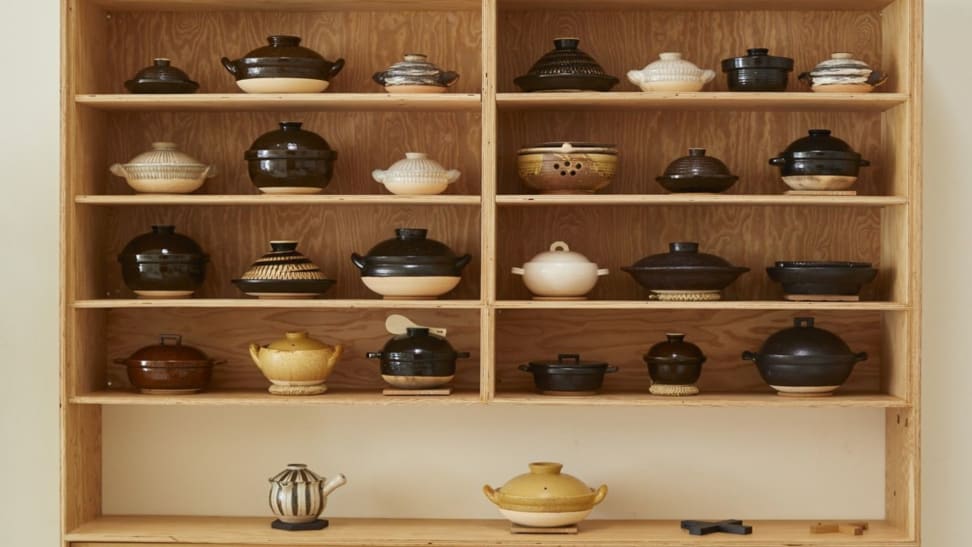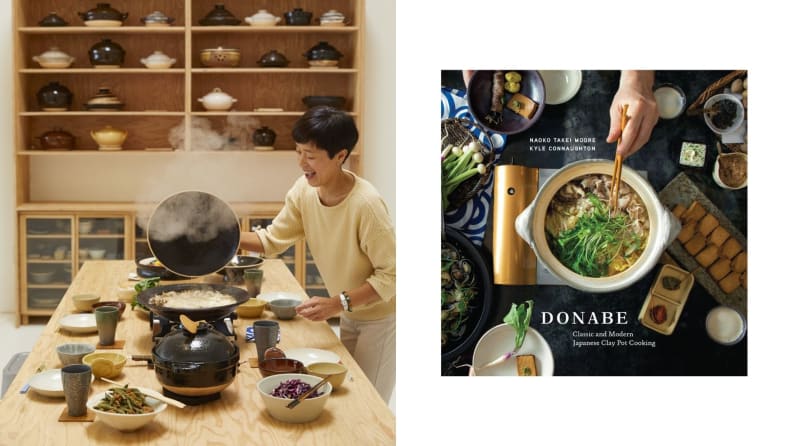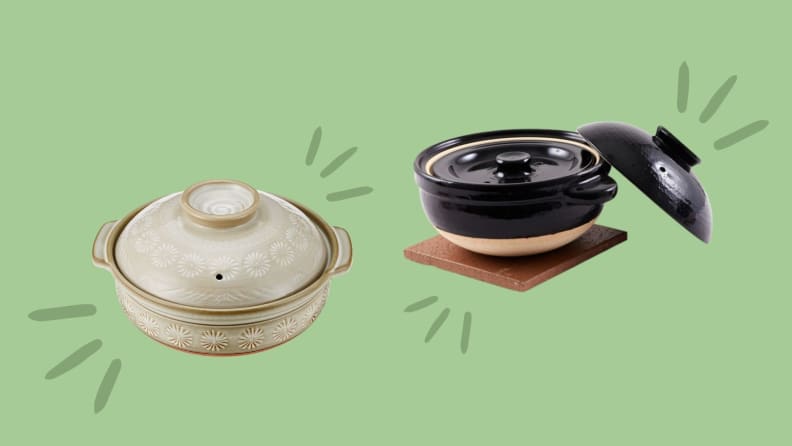My donabe is the best kitchen tool I’ve purchased all year
Here’s why you should own this clay pot, according to Mrs. Donabe herself.
 Credit:
Toiro
Credit:
Toiro
Products are chosen independently by our editors. Purchases made through our links may earn us a commission.
A donabe is a centuries-old Japanese clay pot originating from the Iga province of Japan, that's traditionally used to cook hot pot, soup, stew, and rice. I’s my favorite addition I’ve made to my kitchen in the last year, but not for the reasons you might think. It’s not time-saving, or hands-off. In, fact it’s the opposite. But it’s taught me more about cooking than I’ve learned in a long time and it’s given me a renewed sense of joy in the kitchen. For that, I am very, very grateful.
Learning more about donabe

Naoko Takei Moore is the founder of Toiro and author of Donabe: Classic and Modern Japanese Clay Pot Cooking.
As a white person who grew up in the South, my cooking knowledge is most rooted in the traditions of that region, with a healthy dose of Italian influence from my dad’s side. I’m a confident, curious home cook, but I knew I would need some expert guidance when it came to getting comfortable with my new donabe, so I turned to Naoko Takei Moore aka Toiro founder Mrs. Donabe, and the author of Donabe: Classic and Modern Japanese Clay Pot Cooking.
When I got on the phone with Moore to discuss donabe cooking, she got me excited about all the potential of my new pots.
“I use it for just about anything,” Moore said. “When you cook something in the donabe, even something really simple, it really makes me feel happy, really peaceful. When you open the lid, the excitement never gets old. Cooking with donabe is all about the whole experience—it’s about communal dining and sharing food. There’s no reason to be intimidated.”
She also soothed my nerves about the possibility of breaking the pots, something I was very concerned about.
This pot isn’t for everyone
If you’re looking to save time, or if you’re the type of person who finds a cast-iron skillet too fussy, a donabe may not be for you, as they do require some basic upkeep and can definitely not be washed in a dishwasher.
Also, and importantly, donabe can’t be set on an electric burner so you’ll need to buy a gas burner if you don’t have a gas cooktop. They’re also fragile: Place a donabe over high heat, fill a hot donabe with super cold water, or simply drop it, and it can definitely break.
How much does a donabe cost?

I tried two Japanese-made donabes, one from Ginpo and one from Toiro.
I began my donabe journey with two donabe: the first, a double-lid Kamado-san in the 2-cup size from Toiro and a larger, more affordable donabe by Ginpo, another Japanese company.
Neither are cheap, necessarily; the Toiro donabe runs $135 (depending on the size) and the Ginpo is about $70. But the quality difference was unmistakable. Though it was considerably smaller, the Toiro donabe’s walls were noticeably thicker than the Ginpo, which impacted the speed at which each pot heated, and how long they stayed hot.
How to season donabe
“If you treat a donabe right, it can last for many, many years. Some people pass them on between generations,” Moore said. “The donabe we carry come from the region of Japan called Iga, and the entire region used to be the bed of a lake, so the clay creates a porous body—this particular clay is extremely durable over high heat and consecutive uses. The more you use it, the more the glaze will crackle, which is a sign of the strength of the pot.”
Encouraged by this, I seasoned the two donabe—a straightforward process that involves slowly simmering cooked rice in water until it forms a thick paste—and started my journey by simply cooking a few pots of rice. Moore explained that donabe produce superior rice because they heat slowly, which helps highlight the natural sweetness of the grains.
I can’t say I noticed a huge flavor difference in the rice, but every pot I made came out absolutely perfect: fluffy, individual rice grains that were toothsome but neither crunchy nor mushy. For someone who has long struggled to pull off excellent rice on the stovetop, it was a revelation. As an added bonus, the ceramic stays hot for a long time, so you can serve the rice out of the pot without worrying that it will get cold.
What can you cook in a donabe?
To get comfortable, I made a handful of recipes in each donabe: scallop and butter rice with chives, a tofu stew, a noodle soup, a whole steamed fish, and even a steamed chicken recipe that yielded some of the most tender, juiciest bites of chicken I’ve ever cooked. Both donabe were wonderful to cook with; I liked the wide top of the Ginpo donabe, which allowed me to create a better ratio of toppings to rice to toppings, but I noticed that the thinner walls meant that it heated up faster and was more likely to scorch the bottom of whatever I was cooking.
The thicker Toiro donabe never scorched anything and did a much better job creating that bottom layer of crunchy, crispy rice that I covet. It also stayed hot far longer, and I prefer its super-simple aesthetic to the flower-adorned exterior of the Ginpo.
When I spoke with Moore, she encouraged me to try cooking non-Japanese recipes, simply throwing something together that I might make in a different pot.
“If you already have your favorite soup or stew recipe, start with that,” Moore told me. “It doesn’t have to be Japanese. Donabe is really not about a specific cuisine. If you like making, like, chicken and tomato stew, maybe start with that and then perhaps you might start to feel interested in some other things. Then, if you happen to be interested in traditional donabe cooking, you can start to make a hot pot, because that’s really simple and easy. But start with something you’re familiar and comfortable with, and then grow from there.”
For my next round of donabe cooking, I took Moore’s advice and tried a simple chicken noodle soup—it was delicious! Donabe aren’t good for sautéing, but the simple chicken stock I made in the pot was flavorful and rich, though it took a little longer to cook than it might have in a regular pot.
What you’ll need to get started

The donabe clay pot originated in the Iga province of Japan.
In addition to the donabe themselves, and the cookbook, I also ended up purchasing a handful of Japanese pantry staples. If you already cook a lot of Japanese food, you might already have items like short-grain rice, bonito flakes, and sake in your pantry, but I didn’t.
Most of the new-to-me ingredients that Moore’s cookbook called for were affordable and easy to find at my local Asian grocery store. Anything that was less common included a substitution. I appreciated this opportunity to expand the range of items I was cooking (hello pandemic cooking fatigue), but this is another element of donabe cooking to consider.
That said, if you want to become a better cook, learning to use a donabe is a great way to gain confidence and expand your repertoire. Rather than time recommendations like “simmer for 5 minutes” many donabe recipes offer indicators based on scent, sound, and the amount of steam coming out of the lid, which forces you to be far more in touch with the cooking than you might be with even a skillet.
Should you buy a donabe?
If you have a gas stove, love to cook, are interested in getting to know a whole new world of recipes, and want to impress your friends and family, a donabe is a powerful, sensual tool with the ability to transport you and get you excited once again about simple, delicious meals. If you do decide to buy one, I recommend going all the way and purchasing one from Toiro—I think you’ll notice the superior heat retention and overall quality. And don’t forget to add a copy of Moore’s cookbook to your purchase.
Cooking tools like Instant Pots and air fryers use technology to make cooking faster and more hands off. And while those tools are certainly helpful to some, I’ve always felt that they robbed me of my favorite parts of cooking: the slow curl of steam that forms over a pot of beans, or the way a roast chicken perfumes my house as it cooks in my oven. The donabe feels like the opposite of an hands-off cooking devices: intuitive rather than time-oriented, traditional rather than technological, and grounding rather than time-saving.


